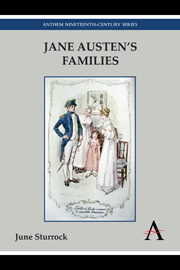Book contents
- Frontmatter
- Table of Contents
- Acknowledgements
- References and Abbreviations
- General Introduction
- Part I Family Dynamics
- Introduction
- Chapter One The Functions of the Dysfunctional Family: Northanger Abbey, Sense and Sensibility, Pride and Prejudice
- Chapter Two Spoilt Children: Pride and Prejudice, Mansfield Park and Emma
- Chapter Three “Usefulness and Exertion”: Mothers and Sisters in Sense and Sensibility, Mansfield Park, Emma and Persuasion
- Part II Fathers and Daughters
- Conclusion: “Creative Attention”
- Notes
- Select Bibliography
- Index
Chapter Three - “Usefulness and Exertion”: Mothers and Sisters in Sense and Sensibility, Mansfield Park, Emma and Persuasion
from Part I - Family Dynamics
- Frontmatter
- Table of Contents
- Acknowledgements
- References and Abbreviations
- General Introduction
- Part I Family Dynamics
- Introduction
- Chapter One The Functions of the Dysfunctional Family: Northanger Abbey, Sense and Sensibility, Pride and Prejudice
- Chapter Two Spoilt Children: Pride and Prejudice, Mansfield Park and Emma
- Chapter Three “Usefulness and Exertion”: Mothers and Sisters in Sense and Sensibility, Mansfield Park, Emma and Persuasion
- Part II Fathers and Daughters
- Conclusion: “Creative Attention”
- Notes
- Select Bibliography
- Index
Summary
Early in her career, Jane Austen created in Lady Susan one of the worst and most entertaining of fictional mothers. Among Austen's critics, indeed, there is a tendency to regard the mothers in all her novels as being either bad or dead. “Competent mothering is something of a death sentence for a woman” in Austen's novels, according to Peter Graham (67), alluding to the deaths of Lady Elliot, Mrs Woodhouse and Mrs Tilney. Jan Fergus reads Austen's tendency to subtract the mother either through death or through absence as a narrative device in the tradition of the eighteenth-century novel of self-education, noting that the presence of an effective mother “would prevent the heroine from error and thus from educating herself” (89). This comment certainly applies to Northanger Abbey, for Catherine must be taken from her large and happy family and her excellent mother before she can learn a little about life and begin to grow up.
Austen's other novels, however, diverge from the eighteenth-century tradition that Fergus discusses. In these more complex explorations of family life the mothers of the heroines, whether present or absent, influence their daughters' narratives powerfully. In virtually any family, the presence or absence, as well as the character, of the mother affects the children both as individuals and in relation to each other. In the four novels discussed here Austen represents the mother as a determining factor in the relations between her daughters.
- Type
- Chapter
- Information
- Jane Austen's Families , pp. 47 - 64Publisher: Anthem PressPrint publication year: 2013



